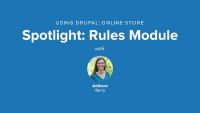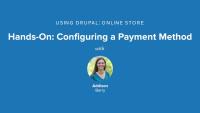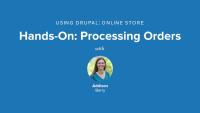In this lesson we'll create a nice interface for browsing our products. We will categorize our product displays using the taxonomy system to get our like items grouped together. We'll walk through the process for creating a catalog vocabulary and terms, and then configure the content type and product type to bring it all together.
Additional resources
With our products nicely categorized, and the individual items looking good, the last step is to design a top-level catalog overview page using the Views module. In this lesson we'll create a catalog view and use relationships to pull in our product data. We'll also need to aggregate multiple products into one item so we don't have a crazy list of every possibility as individual items, and we'll wrap it all up nice and tidy by grouping the products based on taxonomy.
Additional resources
It’s easy to imagine that different kinds of stores might have certain things they want to have happen when various events take place throughout the purchasing process. For example, if someone adds more than 10 of an item to his cart, a store might want to provide a 10% discount. Or if someone was anonymous and then registers or logs in, a store might want to assign his old shopping cart to his newly found account. Traditionally, this kind of custom logic would have to be done in code by a programmer. However, the Rules module exposes a user interface for clicking together custom logic in a web-based interface. This increases accessibility to non-programmers, and also allows for bits of business logic to be shared among multiple sites with the Rules module’s import and export capabilities. In this lesson we'll review the main architectural blocks of the Rules module, covering events, conditions, actions, variables, and data selectors.
Additional resources
In this lesson we'll try a practical example of some Rules module concepts for the Sweet Tees store. Drupal Commerce’s Tax module stores its tax charging in Rules. Before we can open up our store to the public, we need to ensure that all applicable sales taxes are being applied to our items. Because Sweet Tees is based in California, we will need to charge 7.25% sales tax on all products sold if the customer lives in the state of California. This means we need to set up a conditional tax rate to only apply to California.
Additional resources
Of course, it’s one thing to have a bunch of products ready for purchase, but what Sweet Tees really cares about is accepting money for those products. They want to be able to accept credit card transactions on their online store. There's more than what's on your Drupal site involved in this though. In this lesson, we'll discuss merchant accounts and payment gateways—what they are and why you need them, along with providing payment security.
Additional resources
PayPal is a popular payment processor, especially for new site owners. It allows credit card transactions as well as payments from within PayPal itself. There are predominantly two “flavors” of PayPal’s payment processing tools: Website Payments Standard (WPS) and Website Payments Pro (WPP). For our purposes, we’ll be using Website Payments Standard, since there are no setup fees, no extra security setup required, and we can get started right away. In this lesson we'll create test PayPal buyer and seller accounts, set up access to the test sandbox, and make sure it is working properly.
Additional resources
Now that we have the PayPal side of payments set up, it’s time to set up the Drupal side of things. We’ll do this with the Commerce PayPal module, which is an extension of the main Drupal Commerce package. Just as we saw with Taxes, Commerce payment methods are Rules-enabled for maximum flexibility. In this lesson we'll walk through enabling the PayPal WPS payment method and configuring our PayPal sandbox access so that we can start taking test transactions on our store.
Additional resources
Using Drupal, 2nd edition
Using Drupal source code
Commerce PayPal project
The remaining element of our site is actually implementing the e-commerce portions: an online shopping cart and the ability to process orders, as well as reporting tools to tell us how our store is doing. We will now complete our store configuration by adding a shopping cart, configuring the checkout process, and placing a test order to make sure the whole store is actually working.
Additional resources
In this series, we have covered the basics of setting up an online storefront and shopping cart using the Drupal Commerce package for Drupal. However, there are several additional modules that you will likely want to consider before taking your online store live. We'll take a brief tour of:
Additional resources
In this series, we were able to set up a complete online store for our customer, Sweet Tees, using Drupal Commerce, a powerful, flexible e-commerce framework built on Drupal. We set up a payment system through PayPal’s Website Payments Standard. We also delved into the topic of data imports with the Feeds module, and covered tweaking Drupal’s functionality at various system points with the Rules module. In this lesson we'll tour the Sweet Tees site, discussing our implementation points, and reviewing the modules and resources we used.
Additional resources
Using Drupal, 2nd edition
Using Drupal source code
Up next: Using Drupal Appendix A: Installing and Upgrading Drupal
You may have heard some news about the fact that a new theme has been added to Drupal, named Classy. But what kind of theme is it exactly? Is it a pretty new look for Drupal 8? Well, no. You will still see Bartik as the default theme on your Drupal 8 site, so why another theme? Classy is a new base theme in core, which Bartik and Seven will then use as their bases. The idea here is to provide more flexibility to themers when it comes to choosing default CSS classes.
In this episode Kyle is joined by a few members of Lullabot's front-end army. Kris Bulman, Thomas Lattimore, Helena Zubkow, Marc Drummond, and Mike Herchel open up and discuss a project they have launched: The Front-End Rapport.
We built a nice, simple, easy-to-use site for our clients that gave them the tools they needed for discussions and a knowledge base. We set up a forum that displays only posts that are in the user’s language and a knowledge base book where all of the site members can create translations for the pages. The major need for this community was being able to use multiple languages and easily extend those languages in the future. Using Drupal’s core internationalization features with a handful of contributed modules, we have given them a very flexible multilingual solution. In this final lesson we'll tour the Blue Peak Fanatics site, discuss our implementation points, and review the modules and resources we used to build this site.
Additional resources
Using Drupal, 2nd edition
Using Drupal source code
Up next: Using Drupal Chapter 9: Online Store
There are a lot of tools available for working with multilingual sites, and we've implemented the main pieces we needed to build the site that Blue Peak Fanatics needs. In this lesson we'll take a look at some more modules we might consider down the road.
- Language icons
- Language switcher dropdown
- Transliteration
- Translation overview
- Translation table
Additional resources
The last little thing we need to do to clean up our site is to get our Home tab in the Main menu translated as well. Everything else in the menu is now translated, but the Home menu item isn't from one of the other features we've created. It's just a regular menu item. In this lesson we'll enable multilingual menus and get that home page tab translated.
Additional resources
When using Drupal’s taxonomy system, we need to find a way to sync the terms that we create to keep the taxonomy selection limited to just the terms for a given language. We don’t want all of the different languages showing up at the same time when someone is looking at a vocabulary or individual terms on the site. We're going to work with taxonomy to create our site's forum. The Forum module’s containers and forums structure is built on Drupal’s core taxonomy, so it is also creating a new vocabulary on our site. The forums on our client’s site need to display the threads that follow the same content selection rule as the rest of the content on the site. That is, we’ll only show the forum posts for the selected language. The site will have preset containers and forums, and then users may post to them using whichever language they choose.
Additional resources
We’ve translated the site name, but we still have other stubborn text on the site that we couldn't select on the Variable translation page. Our content types for the site are still using English for the content type name on the “Create content” page, and for field names when making new content. In this lesson, to fix this up, we'll walk through translating content type names, the Title label on the content type, and also see how to tackle the field labels as well.














